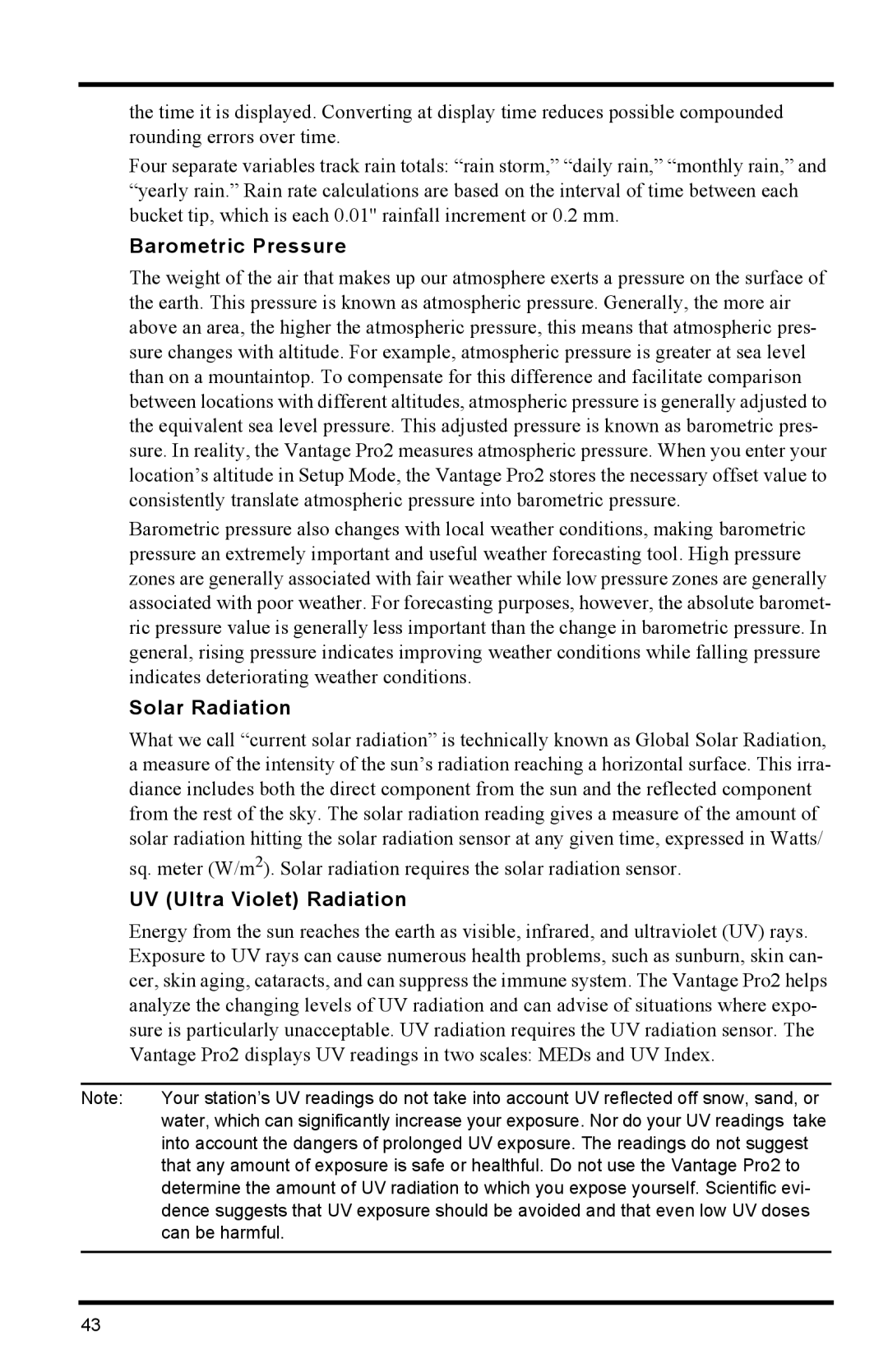
the time it is displayed. Converting at display time reduces possible compounded rounding errors over time.
Four separate variables track rain totals: “rain storm,” “daily rain,” “monthly rain,” and “yearly rain.” Rain rate calculations are based on the interval of time between each bucket tip, which is each 0.01'' rainfall increment or 0.2 mm.
Barometric Pressure
The weight of the air that makes up our atmosphere exerts a pressure on the surface of the earth. This pressure is known as atmospheric pressure. Generally, the more air above an area, the higher the atmospheric pressure, this means that atmospheric pres- sure changes with altitude. For example, atmospheric pressure is greater at sea level than on a mountaintop. To compensate for this difference and facilitate comparison between locations with different altitudes, atmospheric pressure is generally adjusted to the equivalent sea level pressure. This adjusted pressure is known as barometric pres- sure. In reality, the Vantage Pro2 measures atmospheric pressure. When you enter your location’s altitude in Setup Mode, the Vantage Pro2 stores the necessary offset value to consistently translate atmospheric pressure into barometric pressure.
Barometric pressure also changes with local weather conditions, making barometric pressure an extremely important and useful weather forecasting tool. High pressure zones are generally associated with fair weather while low pressure zones are generally associated with poor weather. For forecasting purposes, however, the absolute baromet- ric pressure value is generally less important than the change in barometric pressure. In general, rising pressure indicates improving weather conditions while falling pressure indicates deteriorating weather conditions.
Solar Radiation
What we call “current solar radiation” is technically known as Global Solar Radiation, a measure of the intensity of the sun’s radiation reaching a horizontal surface. This irra- diance includes both the direct component from the sun and the reflected component from the rest of the sky. The solar radiation reading gives a measure of the amount of solar radiation hitting the solar radiation sensor at any given time, expressed in Watts/
sq. meter (W/m2). Solar radiation requires the solar radiation sensor.
UV (Ultra Violet) Radiation
Energy from the sun reaches the earth as visible, infrared, and ultraviolet (UV) rays. Exposure to UV rays can cause numerous health problems, such as sunburn, skin can- cer, skin aging, cataracts, and can suppress the immune system. The Vantage Pro2 helps analyze the changing levels of UV radiation and can advise of situations where expo- sure is particularly unacceptable. UV radiation requires the UV radiation sensor. The Vantage Pro2 displays UV readings in two scales: MEDs and UV Index.
Note: | Your station’s UV readings do not take into account UV reflected off snow, sand, or |
| water, which can significantly increase your exposure. Nor do your UV readings take |
| into account the dangers of prolonged UV exposure. The readings do not suggest |
| that any amount of exposure is safe or healthful. Do not use the Vantage Pro2 to |
| determine the amount of UV radiation to which you expose yourself. Scientific evi- |
| dence suggests that UV exposure should be avoided and that even low UV doses |
| can be harmful. |
|
|
43
